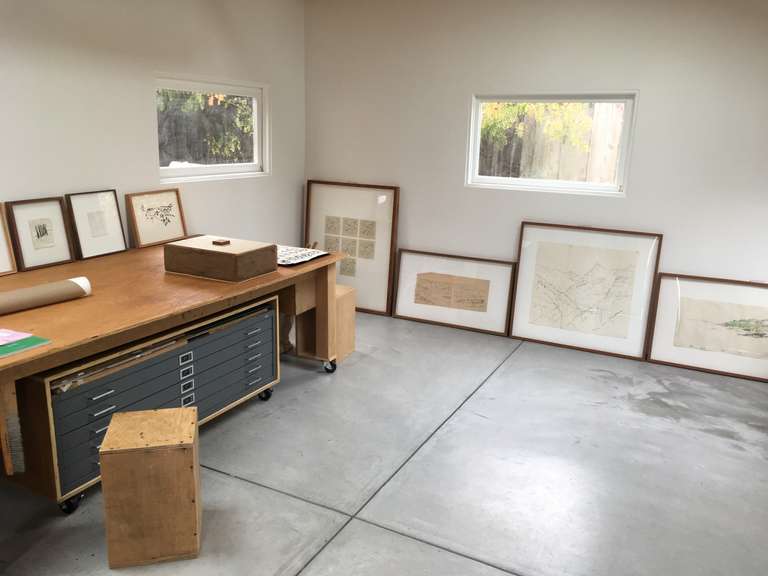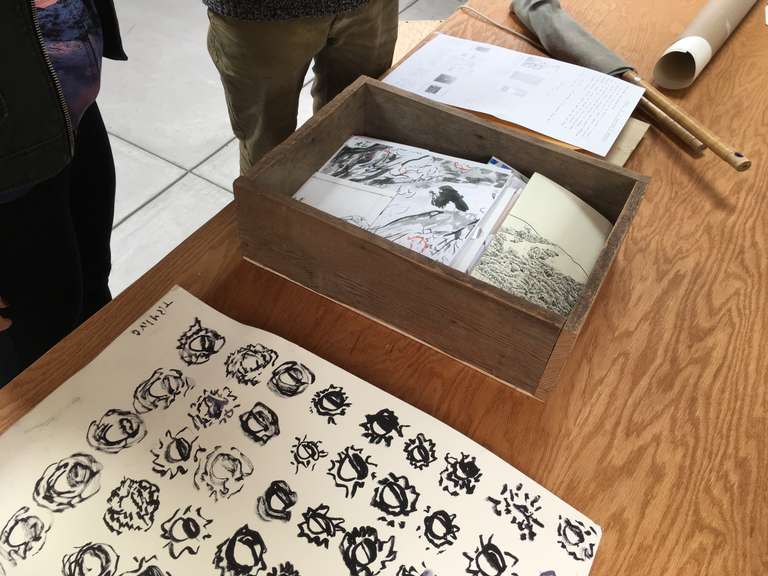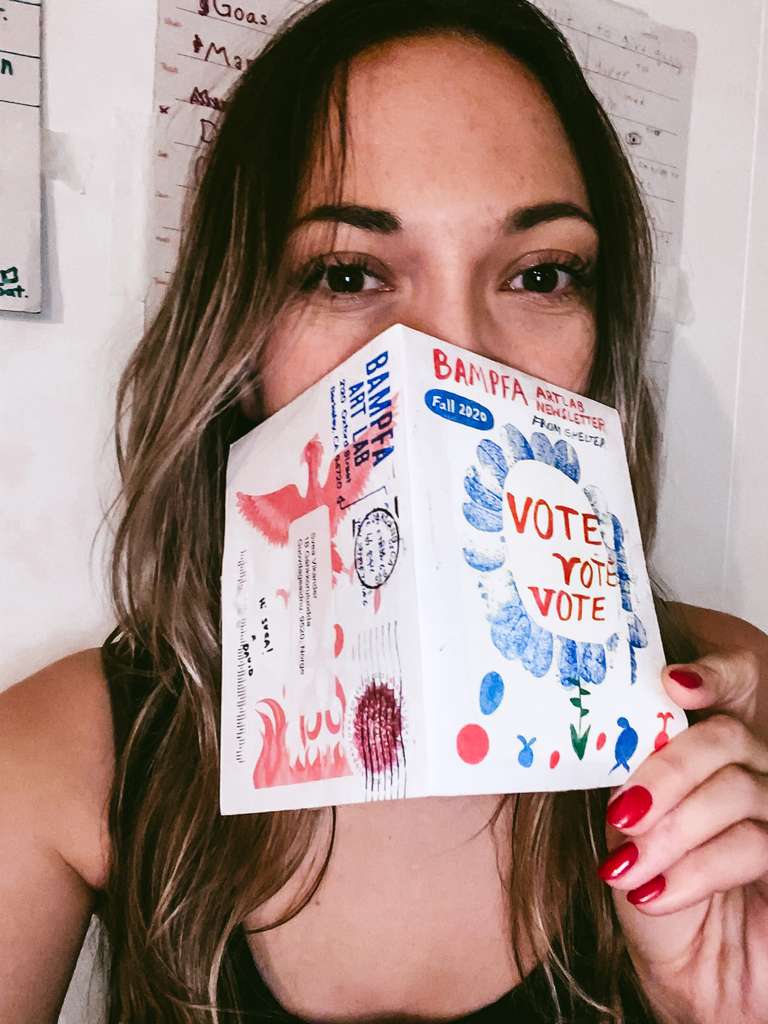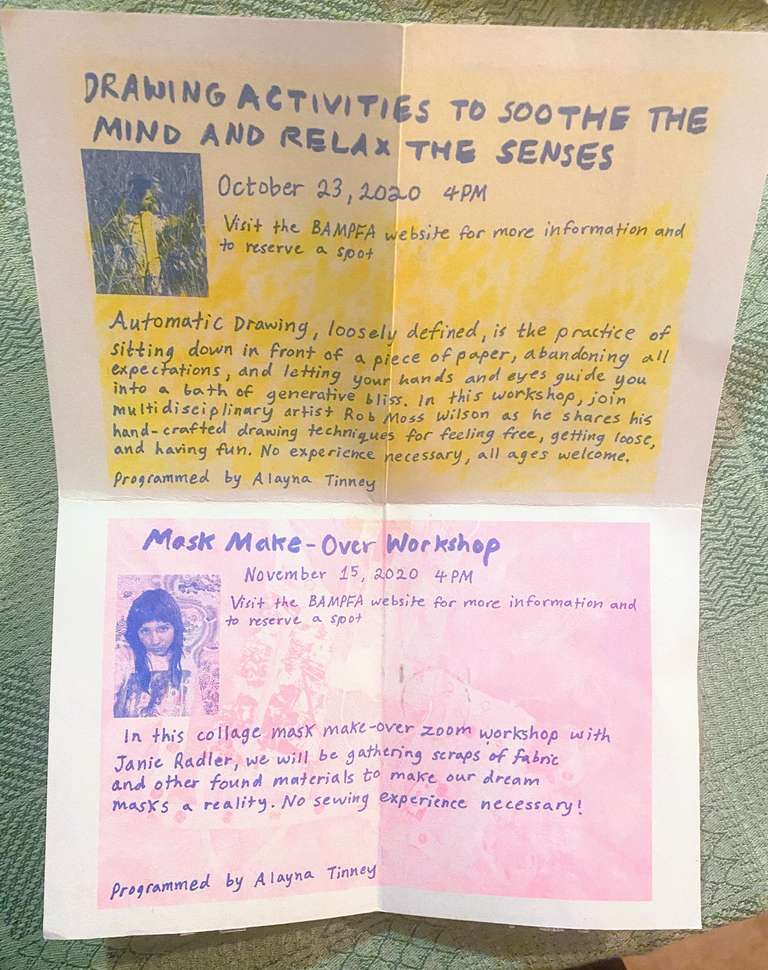When David Wilson's Garage got Real Bloody

Join us as Svea runs into the car in her pyjamas and Jozefien is forced to scrunch under a low wooden table. All in the name of art (and Wilson, also in the name of Wilson). Our art crush David Wilson shows us his pristine “garage”, bougainvillea, and tape recorder. He talks FaceBook artist residency, drawing, bringing people together to sing and eat, and what happened when he had to cut just a few extra pieces for the garage ceiling. It rains. That’s very romantic. We demand snail mail and access to his outdoor shower.
David on Instagram: he doesn’t.
David’s website: http://www.davidwilsonandribbons.com/
Listen to the episode
Transcription of David Wilson's interview
Abbreviations
jb: Jozefien Buydens
sv: Svea Vikander
vo: Voice Over (Svea or Jozefien)
dw: David Wilson
__
jb: This week we have a crush on David Wilson
jb: But DW is a very talented artist and he makes works that are aesthetically pleasing, socially pleasing, and mail-pleasing too
sv: Male pleasing? Tell me more about this male pleasure component.
jb: Mm, so this male pleasure component, and this might be disappointing, is a postal mail
sv: ahhh
jb: pleasure component
sv: Yeah yeah yeah, I knew that, yup
jb: So, David Wilson you can write him a letter and he'll write you a letter back
sv: That's amazing, I love that. So did you send him a letter yet?
jb: Uh, no I didn't
sv: Oh
jb: But I think you did, right? Because you got mail from David Wilson
sv: Oh, I did get mail from DW but I never sent him a letter, he just sends me things.
jb: OMG you lucky woman. [laughter] So this is very postal mail pleasing, I would say
sv: Yes, definitely, that's definitely what I would call it
jb: It's like a party in your mailbox!
sv: Shall we, let's take them. Let's go
jb: Yup, it's exciting
sv: I'm glad you're excited. Let's gooo
dw: My name is David Wilson and I'm an artist and I live in Oakland, California, and I like to draw and I like to organise things
sv: So Jozefien picked me up, and I was not available because I was on a call, because I had completely forgotten this interview, and so I'm actually wearing my pyjamas
jb: Oooh, nice!
sv: That's my pyjamas [giggling] but at least I'm wearing a bra. Top notch, Svea!
jb: Top notch, you are so on top of it
vo: We pull up to David's house
sv: It's going great, it's going great, I appreciate it.
vo: It's a single family home on a tree lined street. Also, the BART tracks are very close by.
sv: Did he say 'go to the front door'?
jb: Uhh, there was nothing as like that in the mail
vo: We walk up the front stairs but
sv: Cuz I hear, like, kids in here
vo: We decide not to ring the doorbell cuz it sounds like there's kids inside
jb: Oh really? Huh.
sv: Is there a path to the back?
jb: Well, on the other side I thought...
sv: Maybe we should try that before we disturb a family
jb: Before we ring the doorbell
vo: We push open the unlocked wooden gate and step inside
sv: OK, let's hope we don't get shot, this is America. OH MY GOD LOOK AT THIS BOUGAINVILLEA, IT'S SO GORGEOUS
jb: Svea gets really excited about a huge bougainvillea plant that's growing up the side of the house and hanging down over a large handcrafted wooden table
sv: *shimmer noise* I love bougainvillea and if you do too you should follow this strange little IG account called for_the_love_of_boug. *shimmer noise*
sv: This whole thing with the table... Hi! How are you? Sorry we're late
dw: Oh, no worries
sv: Beautiful place
dw: Welcome
jb: Hi!
dw: Nice to see you again
vo: We meet David, who is standing in his immaculate art space. It's not quite a studio because he does most of his artwork outside so this is a place for carefully storing artwork. For thinking about things, for designing things. Organising things.
jb: It's very nice. It's a beautiful art studio
dw: And since I work outside primarily, I wanted to be able to have the kind of space that would be more for looking at art since making work tends to happen outside so not needing it to be, basically the function is to look at things.
jb: There's a lot of beautifully framed drawings of natural items, landscapes, the great outdoors.
dw: It was formerly a garage, back when cars were small, and it was built in, I think, 1916, same year as our house. And when we first moved in, again, this was leaky, the floor would flood, it just was a very rough space. We are now kind of after a year of me chipping away at renovating the space we're in now, a clean and art-safe kind of space. So the floor is concrete and was recently re-poured and kind of has that freshness to it. The ceiling was a little exercise, where I used the wood that I use to make frames and basically used strips, this was about a 10 hour project of standing in front of a table saw, which did of course end up in an emergency room visit.
sv: Did it? Really?
dw: It did, yeah it did, yeah,
jb: And of course, Svea wants to hear more about that.
sv: What happened?
dw: Well, of course, when I got to the point where I had safely felt like I had milled enough of this material to do this ceiling, I thought I don't wanna have to realise I've come up short, so let me do just even more. And that was, my eyes were glazed over, and I just reached in, just touched the saw blade as it was spinning.
sv: Do you have a scar?
dw: Well it's amazing, the body, it's a very subtle scar on the tip of my thumb... I reached in
sv: Where, it's horizontal?
dw: Yeah it's kind of just across the tip there—
sv: Wow, hardly at all.
dw: I just reached in there and just zip, right across there, and so of course there is one piece in here that's got a little bloodstain on it.
sv: Where is it?
dw: Ummm
jb: And of course, Svea wants to find that bloodied piece on the ceiling
dw: The actual piece is on the side of the house, but there's a little drop...
sv: This is the literal sweat and blood of the artist
dw: Well you can see some of the saw marks there, I think it was in one these ones...
sv: How many stitches?
dw: It was actually the glue. They went for the glue. But anyway I'm whole and the room, you know, has that little extra ju-ju. But yeah it's a wood ceiling, strips of old growth douglas fir.
And yeah, you're pointing at my cassette player, which is probably my twelfth one of those, if not more, I have a real relationship with that particular model, it's a, you know, battery powered, it has a built in microphone, a really nice condenser microphone, so it tends to make everything sound good if you're recording outside. Which I tend to do, with a lot of the kind of gathering projects that I do. So yeah there's a chunk of wood serving as a stand, also a storage solution.
sv: Cool
dw: Yeah, got some tapes in the works
sv: Do you listen to music when you're working?
dw: Yeah I do, I really like listening to music
sv: What are you listening to now?
dw: Let's see right now, I think it's uh...My dentist growing up as a child, he was a very awkward Vietnam vet who didn't have much of an ease of rapport with his younger kids, who he worked on. His son was a bootleg tape guy at a flea market and offered them as a way of connecting with the kids in his practice.
But I was, in the end, really the only kid who was taking him up on it. So every time I went to his place he would just let me go wild in, like, the bootleg tape room of the dentist office. So this is the Talking Heads live, this is from the Stop Making Sense Tour so yeah, live in Milwaukee, ‘84. So this is how I got a lot of music actually.
sv: What are these here?
dw: This was a gift from my friend Kelly Best, who is a woodworker in the Bay Area. He's an aesthete in his own very rough, natural way. I forget which tool store this is from, it might be from Hida tool down in North Berkeley but yeah, I've since worked with him and a few others.
Paul Discoe, who is kind of like an OG woodworker in West Oakland, who was part of the first wave of the San Francisco Zen Centre coming to the Bay Area, and was sent by Suzuki Roshi, the teacher, to go to Japan to learn temple carpentry in the 70s. He lived there for a few years.
He's just a real resource in this pre-industrial Japanese style carpentry and I've worked with him and a group of people on a couple of projects, but one more involved five year long house building project; so yeah, this is a chisel I am holding, you can see I have not taken the best care of it. There's chips and things in the front, which Paul would not be happy with, but the first phase of that class was basically learning to sharpen your chisel on a stone, a wet stone, which I missed actually, I was working on a project when I arrived.
jb: So you never learned it
dw: I never like learned the proper technique. I'm always like, am I doing it right? Well also, I'm a little, I'm a little neglectful and lazy, but that's ok.
vo: David shows us his catalogue of invitations.
dw: I made this box and started putting this together...
vo: Paper archived in a hand-made wooden box—and they are literally invitations, to music events, art events, community events.
dw: I like how it came out. So It's basically a photocopied, um, little guide to what's in this box with these miniatures.
sv: What was the FaceBook thing you did?
vo: David was the first artist in residence at FaceBook and he invited the employees to hang out on the salt flats near their offices.
vo: He also made them return the invitation in a wooden box if they wanted a print of one of his salt flat drawings.
dw: And then having these incidental little conversations with their neighbours of like, "Oh, I meant to do that, do you have any extra?" And being like—
vo: And if they didn't do it..? He didn't give it to them
dw: 'Oh no sorry, that was kind of a point, wanting to have that kind of commitment to each other,' you know that kind of little, teaching them a lesson.
sv: They're like ‘WHAT?!’
dw: Yeah!
sv: ‘The artist, not at my service??’
dw: Yeah, so it was kind of cool, I had a good experience.
sv: Do you do any artwork outside here?
dw: At my house?
sv: Yeah
dw: I'll draw outside but mostly it's by design an incentive to kind of walk,
sv: To go onsite
dw: But I can show you something which is kind of cool.
jb: It's the coolest thing ever
sv: No way! You have an outdoor shower?
dw: And, uh, an outdoor toilet [flushes toilet]
vo: An outdoor shower. In Oakland.
sv: What's this handle from?
dw: The handle was sent to me by my friend who lives in Cape Cod who I spent a lot of time with growing up
sv: That's amazing
jb: I want one… Right now.
sv: But do you shower out here?
dw: Yeah, this is where I shower and often go to the bathroom
sv: Oh, you're toilet paper is all soggy in the rain
dw: Yeah, I have to start...
vo: We head back inside and look for our best potential audio.
sv: Wait, does that come out?
dw: We can roll it out, yeah...
sv: OK, how flexible are you?
dw: In terms of,
sv: Like would you be
dw: Like, physically flexible?
vo: It's probably the big low table on which David was showing us the invitations he'd made over the years.
dw: Yeah yeah yeah, you know, I'm...
sv: Would you be able to sit underneath that table?
dw: Sure
sv: With us?
dw: We can get under there.
vo: I crawl in first and David offers me a cushion
sv: Oh, well, there's only one
dw: I can sit on this
sv: But what's Jozefien gonna sit on?
dw: Oh...
vo: Then Jozefien begins to pass me the equipment
sv: This one is for us..?
jb: Yeah, one of them, like, one of them
sv: Do these tripods go any lower? Is this as low as they can go?
jb: Is it too high?
sv: Yeah, this is, uh...
vo: And I grab at the mics blindly because I can move my arms but not my head
sv: Yeah, I mean, it'll probably be OK
vo: David crawls in opposite us
dw: OK, I'll sit down, and do more of a recline I think
sv: Yeah you can, but we need you to be close to this guy
dw: Is this close enough?
sv: No
dw: No? How close?
jb: With the small wooden box Svea has manoeuvred into a mic table between us. I'm too tall to sit up entirely so I kind of lean up against Svea's legs. [laughter] Very cozy.
[Musical interlude]
dw: I grew up in Massachusets and I'm an East coast person, so basically hung out in that area for most of my life. I went to school at Wesleyan University in Connecticut so that's also right in the pocket there, so uh, studied art amongst other things there, religion and philosophy and cultural studies, and moved pretty directly into a focus on drawing, coming from a few years in the painting department.
And that was also a shift for me back into what felt like the inspiration and agency of exploration. I kind of always thought about that moment as kind of an important one, just to kind of think about what way you work as the central question in art making, and finding the way to work that enables you to be the way that feels right and the way you wanna kind of engage the world.
So moving out of the studio was very liberating, as well as finding material, such as drawing, that was very portable that just kind of became my counterpoint to movement, moving through this town and getting to know it really deeply. So I spent my final year there kind of making a series of, you know, surveying drawings. I always thought of it as kind of encouraging good habits in terms of mental health too, in terms of engaging walking, and engaging that time, and then I'd also had a background in music.
So planning shows was a part of my early childhood and you know, high school time, growing up in suburban places where there weren't necessarily—if you want to play music for your friends you would do it in someone's house. So that home-based house show self-organising instinct was always a pretty natural thing; and just being a social person, that kind of translated into another side of my work that's evolved as kind of a community based organising practice. So I organise a lot of things and they tend to intersect out in the spaces I find when I'm drawing.
Moving to California when I was 23, I was kind of taken by that intersection and proximity between the city and the open space, so my time drawing again was just a perfect kind of counterpoint to get to know this new area and to take it in through the lines and then share it through the organising so, bringing people together in these different spaces that I had gotten to know while drawing.
jb: Was there a specific reason why you moved to the Bay Area, or why you chose the Bay Area?
dw: Well, it was incidental in some ways but a friend had spent time growing up—she grew up in Chicago but had family out here, so she'd kind of been exposed to this place—and was excited to try and rally a crew of friends to move together. And you know, this was in 2005, so the idea of getting a warehouse space in West Oakland and having a spot to land and you know, get into things and all that was very tangible and real.
I'd never been really out of New England and wanted to see what was going on out here and thought at least I would come visit my friends who were living here and get a sense for what this place was. So I visited and some friends lived very close by here, in Berkeley, and we, you know, we cruised the Berkeley hills, went for that loop in Stinson, up the hill, up Mount Tam, that kind of open space experience, and went to see a show at Lo Bot at the time, which was a warehouse in West Oakland and kind of got a feel for...it felt like a very porous art community and that there was that spirit of self organising was very clear to me immediately.
I had never really experienced a place where you could move into both, like a powerful nature experience and then this powerful community experience within a day, I was like going back and forth. So that kind of blew my mind and it just felt natural. I just could imagine myself here.
The period where I was working at a bakery, I was doing these early morning bakery routes, I would start at 5am and initially I didn't know the area at all so it would take me you know, a couple hours to get through it all. Eventually as I got to know the area and just got to know my route faster and faster, I could go faster and faster and end up with an hour to basically have on my own. So during those little bakery delivery hours I explored found all these different spots that have since been touchstones for various projects and drawing ideas.
And then I kind of proposed organising something there with those friends I was playing music with, and just put together a little evening event and people used a map that we made and came together to hang out and listen to some music.
It was quite a special evening and then turned into a little bit like a seasonal outdoor music series. That particular form lasted about a year or so, or year or two, and then those friends, Daniella and Frank, moved away. I kind of continued on with that and just also, in organising projects that are bringing people together you also are exposing yourself, and getting into all kinds of new conversations and collaborations, and so my ideas moved into broader territories than just music.
It became food collaborations and ideas of building space or kind of creating more of an installation to support the gathering, and more just turning into these kind of open experiences, as opposed to just performance. So that just became its own little series of things that happened from 2006-2010 or so and then I also started getting a little more support from various institutions and things. I started to kind of do more institutional collaborations and it has evolved what that is, but always a strong instinct to get people together.
jb: Is that something that you had to deal with a lot, when you were doing these gatherings, like with like police complaining, neighbours complaining,
sv: This is America
dw: Yeah, which is interesting, and a lot of the designs for organising this kind of came from this funny "what can you get away with" mentality, and it's almost like since there's not like a space that's readily being offered, you have to kind of take it. Even if the taking is kind of a very gentle taking of it, like singing a song with some people (it's not like a hard effect on a space), still you're compromising some rules. So yeah, there was definitely occasions when we would encounter some authority.
sv: Are you cognisant of the privilege that it requires to do this kind of work?
dw: As space becomes more of a challenge for everyone—having had enough privilege like you said, to even think that you're able to do something, to be able to navigate a police conversation safely, is—is a privilege.
jb: Where does 'ribbons' come from?
dw: The name specifically came from a conversation with my friend Frank in a very 24-year old, 25-year-old instinct to name things, it's like ‘a project should have a name’ kind of conversation, so the word 'ribbons', if I'm being honest, came from a conversation about farts, about how we like,
[fart-like machine sound]
jb: Is that my phone? That was my phone!
dw: An apt timing!
sv: So wait, how does ribbons and farts...
dw: So it's again, kind of embarrassing, kind of just what it is, but basically we were having a conversation about how we visualise farts and my friend was saying he had like a cloud kind of metaphor and I was like, well, it's like ribbons, when you walk, like a trail, you can walk around...we kind of joked about that. Anyway, we quickly let go of that first reference point but that, if I have to be honest, is how that name came.
But I found that it's a very nice name because it’s a name that allows for multiple associations, especially gathering projects or organising projects that are inherently collaborative, leaving it open to all kinds of people. I think there's something nice about the idea of being wrapped in ribbon, even if, hopefully it's not a fart ribbon. I hope that's not the effect.
[musical interlude]
OK, to see some examples of these events, look at www.davidwilsonandribbons.com
sv: Wow, welcome back from David Wilson's studio in Oakland. That was so amazing.
jb: That shower in the garden? I want that.
sv: I know, I know, you said that! Maybe he'll let us visit and shower, maybe that can be part of his art project. HEY DAVID WILSON ART PROJECT IDEA let other people shower in your shower. Social practice, woot woot!
jb: woot woot!
sv: Everybody loves social practice. [laughter] What do we have next on the show for today?







